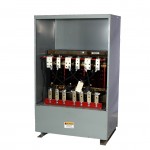By Larry Dahlgren
So someone told you should obtain a transformer.
Before you open your wallet and buy the first transformer you meet, let’s consider the situation a bit.

Buy Dry Type Transformers
You might have just moved your equipment to a new facility and the new location seems to be electrically different from your former location. You do not see the familiar types of disconnects and plugs your former location had or your machines used to be hard wired and now, at their new home, you have a collection of machines with pigtail wires and you are unsure where to connect them. Maybe you just picked up a spare to one of your existing machines or added a machine because there are many available at auction.
You get them to your shop and now find the nameplate voltage is different than your building voltage.
A. AVAILABLE VOLTAGE
Is the actual voltage at the new location any different from the old location?
It could be the same and it might just be referred to by some other name.
Maybe that machine you just picked up at the fire sale has a voltage tolerance that will mean it can work just fine on your available supply.
Consider this single phase example:
There are those who refer to the voltage that comes from a typical wall outlet as 120 Volts. A generation ago that same voltage used to be called 115 Volts or 110 Volts.
Today the do-it yourselfer may connect an electric water heater or electric dryer or range to 240 Volts from a breaker fed from both sides of the common household circuit breaker cabinet. Thirty years ago the water heaters were connected across 230 Volts from both sides of the fuse box if the thinking is that the wall outlets were good for 115 Volts. Maybe that water heater used to be wired to 220 Volts coming from both sides of the fuse box that powered all of the 110 Volt outlets.
This can become complicated even more in multi family buildings, served by the utility with 208Y/120 volts, where each unit is served from two hot legs and the neutral. In that case the wall outlets are still at 120 Volts but there is only 208 Volts between the two hot legs so the dryer and water heater are fed from 208 Volts. Trouble is, a lot of folks just say the specialty socket for the stove or range has 220 Volts and then you have to investigate further and measure safely so you know the actual voltage that is present.
The same type of confusion can extend into the three-phase industrial setting.
People refer to one type of nominal, three phase, three wire voltage as 440, 460 or 480 Volts. Some refer to another type of nominal, three phase, three wire voltage as 220, 230 or 240 Volts.
The two, common, three phase, four wire, nominal voltages are 480Y/277 Volts and 208Y/120 volts.
Measuring (safely) you may discover that the actual voltage, over time, could vary above and below these nominal values. The voltage at times could reach as high as 504 Volts or drop to only 456 volts. Other times the 240 Volt nominal voltage could swing as high as 252 Volts or as low as 228 Volts. Watch out because occasionally 208 volts can swing as high as 218 Volts. You are then left to wonder if a measurement of 216 Volts could mean a stiff 208 Volt system or a very soggy 240 Volt system. Determining the actual voltage and the nominal voltage are critical in the selection of a transformer.
The same holds true for your wall outlets where the acceptable voltage, according to your local power company, can swing from 95% of 120 volts (114 volts) to 105% of 120 Volts (126 volts). Should the voltage drops to 90% of 120 Volts (108 Volts), call your power company.
Hey 114 Volts is only a volt shy of 115 Volts. This means your parents were right again; this time about wall outlets.
Next time we will discuss the equipment you energize with the voltage you have.
See Part 2
Good Luck, be safe and happy transforming.



